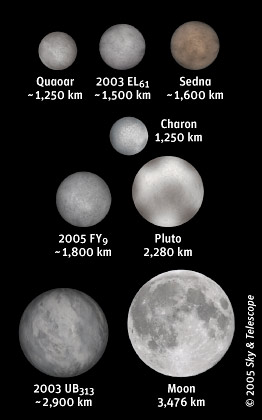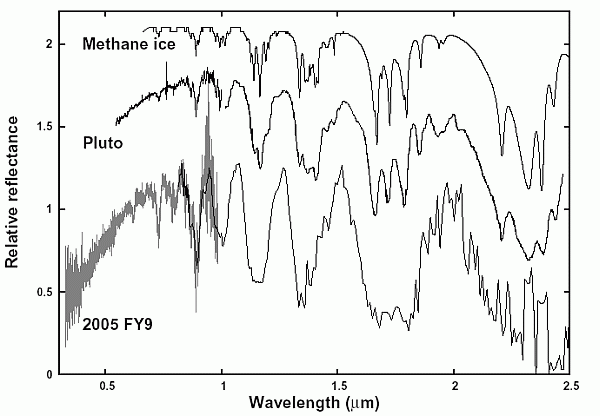The recent discovery of two large trans-Neptunian objects (TNOs) 2003 UB
313 and 2005 FY
9, with surface properties similar to those of Pluto, provide an exciting new laboratory for the study of
processes considered for Pluto and Triton: volatile mixing and transport; atmospheric freeze-out and escape, ice chemistry, and nitrogen phase transitions.
2005 FY9 is the third brightest known TNO, after 2003 UB313 and Pluto. The size of 2005 FY9 is 0.7 times that of Pluto approximately.
The semi-major axis of its orbit is 46 AU, the perihelion distance is 39 AU and the inclination of the orbit is 29°. These values are typical of the classical TNO family.
 |
|
Figure 1. The size of the largest objects known in the outer Solar System compared with the size of the Moon.
|
Visible spectroscopy of 2005FY9 was obtained using the ISIS spectrograph on the WHT, and near-infrared spectroscopy was obtained using the NICS spectrograph on the TNG.
The complete visible and near-infrared spectrum is shown in Figure 2 and compared with the spectrum of Pluto and that of pure methane ice. Figure 2 clearly
shows that the spectra of both TNOs are very similar. They are dominated by strong absorption bands produced by methan ice. In fact, the absorption bands in the spectrum of 2005 FY9 are deeper
than in the spectrum of Pluto as a result of the larger abundance of methane ice in 2005 FY9. Also the colour of the surface of the TNO is red (indicated by the slope of the spectrum), similar
to that of Pluto. This shows the presence of complex organic compounds in the surface.
 |
|
Figure 2. The spectrum of 2005 FY9 compared with the spectrum of Pluto and that of pure methane ice. Notice the strong methan ice absorption bands present in the spectrum of both TNOs (Licandro, 2006). [ GIF ]
|
Until now only one known TNO, Pluto, showed the presence of strong methan ice absorption bands in the spectrum. However, apart from 2005 FY9,
recently these bands were also observed in the spectrum of the largest yet known TNO, 2003 UB313. As shown in Figure 3, the near infrared spectrum of
2003 UB313 is very similar to that of 2005 FY9.
The visible spectrum of 2003 UB313 shows very prominent absorption bands formed in solid CH4. The icy-CH4 bands are significantly stronger than those of Pluto and slightly weaker than those observed in the spectrum of 2005 FY9.
A shift relative to the position of the bands of the spectrum of laboratory CH4 ice is observed in the bands at larger wavelengths, but not at shorter wavelengths, which can be explained by a vertical
compositional gradient. Purer methane could have condensed first while 2003 UB313 moved towards aphelion during the last 200 years, and as the atmosphere gradually collapsed, the composition
became more nitrogen-rich as the last, most volatile components condensed, and CH4 diluted in N2 is present in the outer surface layers.
 |
|
Figure 3. Near infrared spectrum of 2005 FY9 obtained by Licandro et al. (2006) compared with
that of TNO 2003 UB313 from Brown et al. (2005). The similarity of both spectra shows that the surface composition of both objects must be also similar. [ GIF ]
|
References:
-
J. Licandro, N. Pinilla-Alonso, M. Pedani, E. Oliva, G. P. Tozzi, W. M. Grundy, 2006, "The methane ice rich surface of large TNO 2005 FY9: a Pluto-twin in the trans-neptunian belt?", A&A, 445, L35.
- J. Licandro, W. M. Grundy, N. Pinilla-Alonso, P. Leisy, 2006, "Visible spectroscopy of 2003 UB313: evidence for N2 ice on the surface of the largest TNO?", A&A, 458, L5.
- Identificado un Pariente muy Cercano de Plutón. IAC
press release, 19 January, 2006.
- IAC Annual Report 2006 (Report on the project "Física de la Materia Interplanetaria" in "Área de Investigación").





